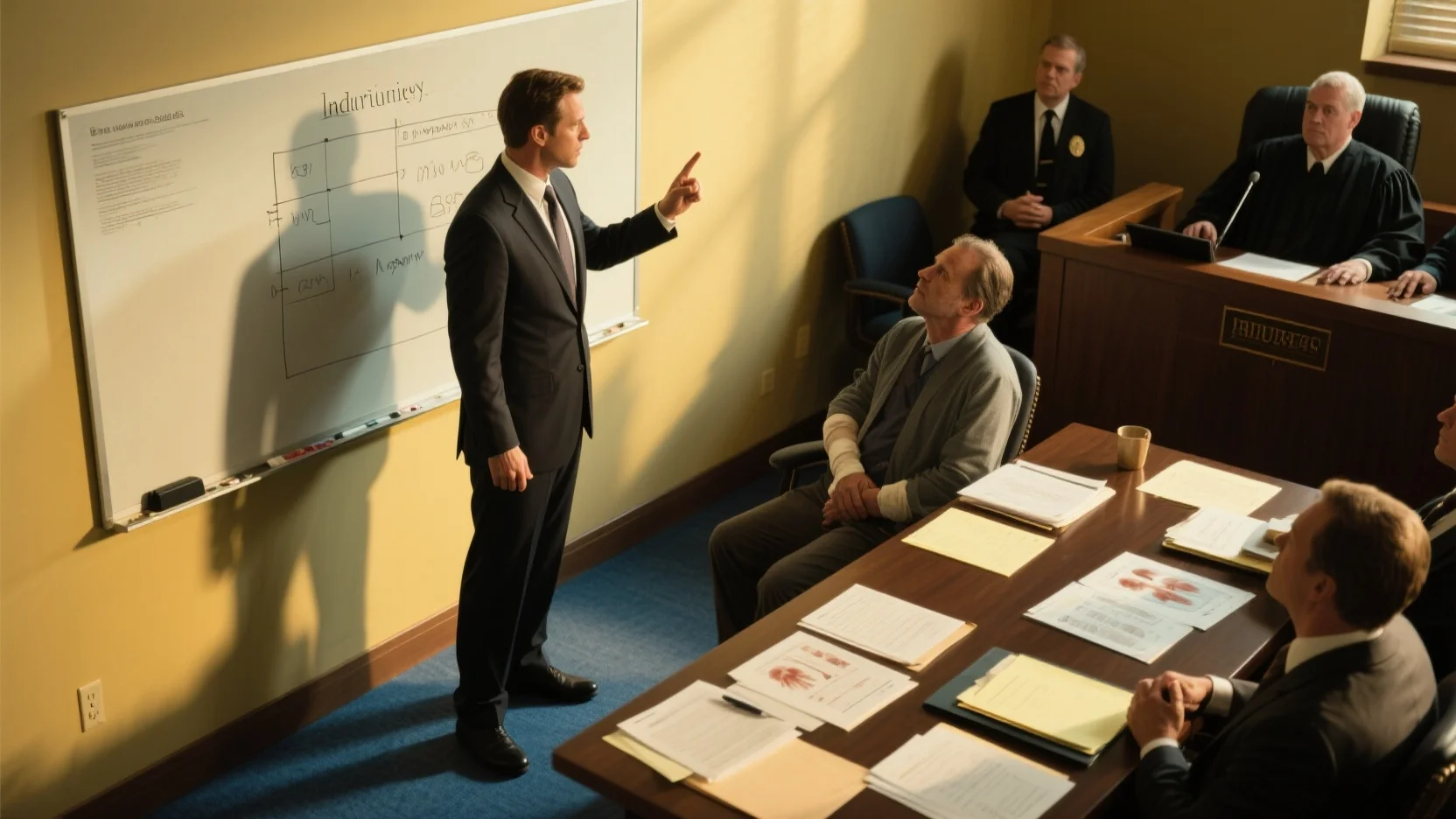
Image Source: pexels
Understanding court defense strategies is essential for anyone involved in personal injury litigation, particularly when considering an in-depth analysis of court defense strategies in personal injury cases. These strategies often determine case outcomes by influencing how judges and juries perceive evidence and credibility. For instance:
- Plaintiffs win 56% of trials before judges but only 51% before juries.
- Success rates vary significantly by case type, with plaintiffs prevailing in 75% of animal attack cases but only 16% in false imprisonment claims.
Preparation and legal expertise play pivotal roles. Attorneys skilled in countering tactics like comparative negligence or disputing injury severity can secure fair compensation, even when fault is shared. Strong evidence and credible witnesses further enhance the chances of success, deterring undervaluation by insurers.
Key Takeaways
- Knowing common defense strategies, like shared fault and full blame, helps people protect their rights and get fair payment.
- Having a good lawyer is important to fight defense tricks. Smart lawyers can argue well, show strong proof, and make good deals.
- Being ready and understanding defense plans can change case results. This helps people handle the tough parts of injury cases.
Overview of Common Defense Strategies
Understanding common defense strategies is crucial in personal injury cases. These strategies often determine the outcome of litigation by challenging the plaintiff’s claims and reducing liability. Below is an in-depth analysis of some of the most frequently employed tactics.
Comparative Negligence
Comparative negligence allows defendants to argue that the plaintiff shares responsibility for the incident. This strategy reduces the plaintiff’s compensation based on their percentage of fault. For example, if a plaintiff is found 25% at fault, they can recover only 75% of the damages. This approach is widely used in jurisdictions that follow comparative negligence laws, as it provides a balanced framework for assigning liability.
Contributory Negligence
Contributory negligence is a stricter defense compared to comparative negligence. In this case, if the plaintiff is even 1% at fault, they cannot recover any damages. This principle applies in only a few states but can significantly impact case outcomes. For instance, a minor oversight by the plaintiff could result in a complete denial of compensation, making it a powerful tool for defendants.
Assumption of Risk
The assumption of risk defense argues that the plaintiff knowingly engaged in a hazardous activity and accepted the potential consequences. This strategy is common in cases involving contact sports or recreational activities like bungee jumping. Defendants often rely on signed liability waivers to support their claims. However, the injury must directly relate to the inherent risks of the activity for this defense to succeed.
Note: Courts often scrutinize the validity of liability waivers, especially if the plaintiff can prove negligence beyond the assumed risks.
Statute of Limitations Defense
The statute of limitations sets a deadline for filing personal injury claims. Defendants can use this defense to dismiss cases filed after the legal time frame. Each state has specific statutes, typically ranging from one to six years. Missing this deadline can result in the loss of the right to seek compensation, regardless of the claim’s validity.
These strategies highlight the importance of preparation and legal expertise in personal injury cases. A thorough understanding of these defenses can help plaintiffs counteract them effectively, ensuring a fair resolution.
Detailed Analysis of Key Strategies
Challenging Witness Credibility
Defendants often challenge witness credibility to weaken the plaintiff’s case. This strategy focuses on creating doubt about the reliability of testimony. Attorneys employ several methods to achieve this:
- Highlighting prior inconsistent statements to expose contradictions in a witness’s testimony.
- Introducing character evidence to question the witness’s reliability based on past behaviors or personal traits.
- Tailoring impeachment tactics to the specifics of the case, exposing weaknesses in the testimony.
These approaches can significantly impact how the court perceives the evidence. A witness whose credibility is successfully undermined may fail to persuade the judge or jury, potentially altering the case outcome.
Delay Tactics and Their Impact
Delay tactics are a common defense strategy in personal injury cases. Defendants use these methods to pressure plaintiffs into accepting lower settlements. The consequences of such tactics include:
- Increased financial strain on plaintiffs, especially those facing medical bills or income loss.
- Emotional distress and prolonged uncertainty, which can discourage plaintiffs from pursuing their claims.
- Exploitation by insurance companies, who leverage the plaintiff’s vulnerability to negotiate reduced payouts.
These tactics often force plaintiffs to compromise, highlighting the importance of legal expertise to counteract such strategies effectively.
Pre-Existing Injury Arguments
Defendants frequently argue that a plaintiff’s injuries existed before the incident in question. This strategy aims to reduce liability by attributing the harm to prior conditions. Defense attorneys may present medical records or expert testimony to support their claims. Plaintiffs must counter this by providing clear evidence that the defendant’s actions aggravated their condition or caused new injuries. Establishing this link is critical to securing fair compensation.
Disputing the Severity of Injuries
Disputing the severity of injuries is another tactic used to minimize damages. Defense teams rely on various forms of evidence to challenge the plaintiff’s claims:
- Medical records that detail the extent of injuries and treatment received.
- Police reports that provide an official account of the incident, including witness statements.
- Expert witnesses, such as medical professionals, who clarify the technical aspects of injuries for the court.
By questioning the severity of injuries, defendants aim to reduce the compensation awarded. Plaintiffs must present compelling evidence to counter these claims and demonstrate the full impact of their injuries.
Legal Principles and Causation
Establishing Negligence and Duty of Care
Negligence forms the foundation of most personal injury cases. To establish negligence, plaintiffs must demonstrate that the defendant owed them a duty of care and breached it, resulting in harm. Duty of care refers to the legal obligation to act in a manner that prevents foreseeable harm to others. Courts evaluate this duty using the "reasonable person standard," which assesses whether a prudent individual would have acted similarly under the same circumstances.
The table below outlines key principles governing negligence and duty of care:
| Principle | Description |
|---|---|
| Duty of Care | The legal obligation to act in a way that protects others from foreseeable harm. |
| Reasonable Person Standard | The level of care that a prudent and sensible individual would exercise under similar circumstances. |
| Breach of Duty | The failure to meet the required standard of care, resulting in harm to others. |
| Foreseeability | The concept that the harm which occurred was a reasonably foreseeable consequence of the person’s conduct. |
When defendants fail to uphold their duty of care, they may become liable for damages. Plaintiffs must provide compelling evidence to prove this breach and its consequences.
Proving Causation Between Negligence and Injury
Causation is a critical element in personal injury cases. Plaintiffs must link the defendant’s negligence directly to their injuries. However, proving causation often presents challenges, such as:
- Multiple potential causes for the injury.
- Pre-existing conditions complicating the assessment.
- Intervening events between the defendant’s actions and the injury.
- Delayed onset of symptoms or injuries.
Courts frequently apply the "but for" test to determine causation. For example, in a car accident where a stationary vehicle is rear-ended, the test asks: "But for the defendant’s negligence, would the injuries have occurred?" In straightforward cases, this connection is clear. However, complex scenarios, such as medical malpractice, may require expert testimony to establish causation.
Role of Forensic Evidence in Personal Injury Cases
Forensic evidence plays a pivotal role in proving causation. It provides objective data that supports or refutes claims of negligence. In straightforward cases, such as a rear-end collision, forensic evidence like crash analysis can confirm the causal link between the defendant’s actions and the plaintiff’s injuries.
In more complex cases, courts rely on forensic experts to interpret evidence. For instance, in Snell v. Farrell, the court inferred causation based on probabilities when multiple explanations for the injury existed. Forensic evidence, such as medical imaging or accident reconstruction, often becomes indispensable in these scenarios. It strengthens the plaintiff’s case by providing scientific validation of their claims.
Tip: Plaintiffs should work closely with legal and forensic experts to ensure that evidence is presented effectively, enhancing their chances of success.
Practical Implications of Defense Strategies

Image Source: unsplash
How Defense Strategies Influence Settlement Negotiations
Defense strategies play a pivotal role in shaping settlement negotiations in personal injury cases. These strategies often complicate discussions by challenging the plaintiff’s claims and presenting counterarguments. Several factors influence the likelihood of reaching a settlement:
- Defense teams may question the credibility of evidence, creating doubt about the plaintiff’s case.
- Vigorous defenses can weaken the perceived strength of the plaintiff’s position.
- Counter-evidence introduced by the defense may shift the negotiation dynamics.
When defendants employ these tactics, plaintiffs may feel pressured to accept lower settlements to avoid prolonged litigation. This underscores the importance of preparation and strong legal representation to counteract such strategies effectively.
Importance of Legal Expertise in Countering Defense Tactics
Legal expertise is essential for navigating the complexities of defense strategies. Attorneys must possess a range of skills to challenge defense tactics effectively:
- Expert witnesses provide objective analyses that can strengthen the plaintiff’s case.
- Detailed evidence analysis helps attorneys identify inconsistencies in witness testimonies.
- Persuasive arguments crafted by skilled lawyers can influence the court’s perception and secure favorable outcomes.
Experienced legal professionals understand how to anticipate and counter defense strategies, ensuring that plaintiffs receive fair compensation. Their ability to present compelling evidence and arguments often determines the success of a case.
Long-Term Impacts on Plaintiffs and Defendants
The implications of defense strategies extend beyond the courtroom. For plaintiffs, prolonged litigation and reduced settlements can lead to financial strain and emotional distress. Medical bills, lost wages, and ongoing treatment costs may exacerbate these challenges. Defendants, on the other hand, may face reputational damage and increased legal expenses if their strategies fail.
Note: The long-term effects of personal injury cases highlight the importance of thorough preparation and effective legal representation. Both parties must weigh the potential consequences of their strategies carefully.
By understanding these practical implications, individuals involved in personal injury cases can better navigate the legal process. This in-depth analysis of court defense strategies in personal injury cases emphasizes the need for strategic planning and professional guidance.
Understanding the defense strategies outlined in this in-depth analysis of court defense strategies in personal injury cases is crucial for achieving favorable outcomes. These tactics, from disputing injury severity to leveraging comparative negligence, can significantly influence case results. Professional legal guidance is essential for navigating these complexities effectively:
- Experienced attorneys advocate skillfully for clients.
- They tailor defense strategies to individual cases.
- Their expertise ensures efficient navigation of personal injury law.
- Attorneys excel at gathering and presenting evidence.
- Negotiating with insurance companies is a critical strength they bring.
By preparing thoroughly and seeking expert legal support, individuals can counter defense tactics and secure fair resolutions.
FAQ
What is the difference between comparative and contributory negligence?
Comparative negligence reduces compensation based on shared fault percentages. Contributory negligence denies compensation entirely if the plaintiff holds any fault, even as little as 1%.
How can plaintiffs counter pre-existing injury arguments?
Plaintiffs should provide medical records and expert testimony to prove the defendant’s actions worsened their condition or caused new injuries unrelated to prior health issues.
Why is legal expertise crucial in personal injury cases?
Experienced attorneys anticipate defense tactics, present compelling evidence, and negotiate effectively with insurers. Their expertise ensures fair compensation and strengthens the plaintiff’s case.


